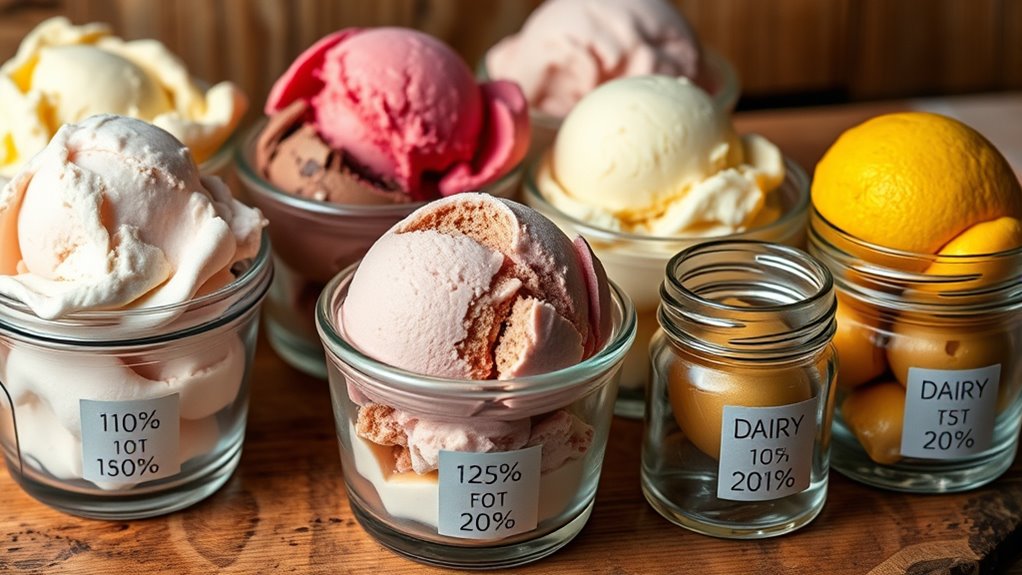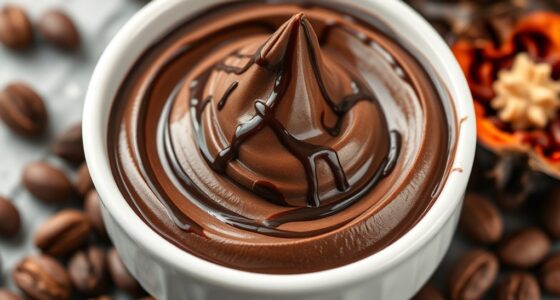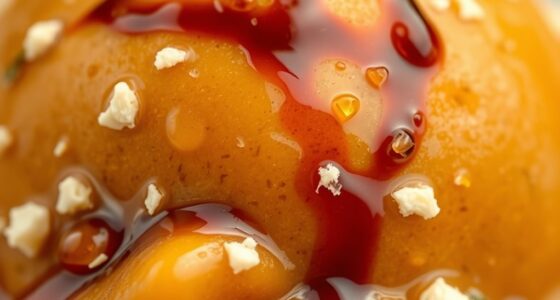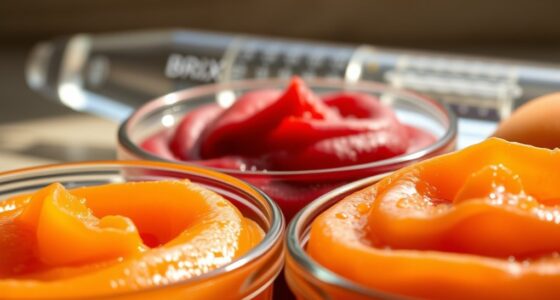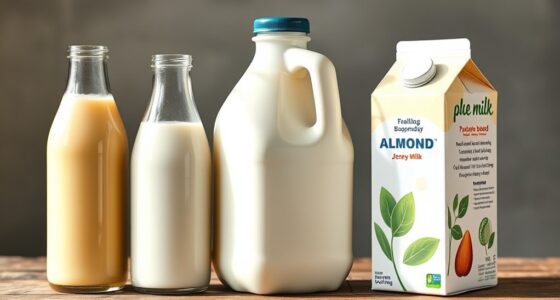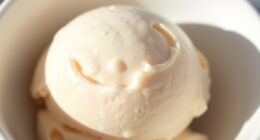Decoding dairy fat percentages helps you create gelato with the perfect texture and flavor. For a light, clear taste, aim for 4-8% fat, while richer, creamier styles benefit from 10-12% fat. Keep in mind that milk’s actual fat content varies, so measuring accurately guarantees consistent results. By understanding these percentages, you can better adjust your ingredients to match your desired gelato style—continue exploring to see how precise measurements can elevate your creations.
Key Takeaways
- Different gelato styles typically use milk with fat contents ranging from 4% to 12%, depending on desired richness.
- Lower-fat gelatos (around 4-6%) emphasize fruit, citrus, or light flavors, while higher-fat versions (8-12%) create creamier textures.
- Accurate measurement of milk’s fat percentage ensures consistency and helps tailor recipes to specific gelato styles.
- Milk labeling varies; understanding actual fat content is essential for precise formulation and achieving the intended gelato quality.
- Techniques like Gerber testing or Babcock method provide reliable fat measurements to decode and adjust dairy fat levels effectively.

Understanding dairy fat percentages can seem confusing at first, but knowing what to look for makes choosing the right product easier. When you’re selecting ingredients for your gelato, it’s important to understand milk composition and how fat measurement techniques influence the final product. Milk composition refers to the proportions of water, fat, protein, lactose, and minerals present in milk. Knowing the fat content helps you determine the richness and texture of your gelato, whether you want it to be creamy, dense, or light. Fat measurement techniques, such as Gerber testing or Babcock method, are used to accurately determine the percentage of fat in milk. These methods provide reliable data that guide you in balancing ingredients to achieve the desired gelato style. Accurate fat measurement is essential for consistency and quality in gelato production.
Different gelato styles call for varying fat percentages, and understanding these differences can elevate your craft. For traditional Italian gelato, the goal is often a lower fat content, typically around 4-8%. This allows the flavors of the other ingredients—like fresh fruit, nuts, or chocolate—to shine through without being overshadowed by fat. If you’re making a gelato that emphasizes creaminess and indulgence, such as a rich chocolate or hazelnut flavor, you might opt for milk with higher fat content, around 10-12%. This increased fat level adds body and smoothness, creating a luxurious mouthfeel that melts beautifully on the tongue.
When choosing milk for your gelato, you’ll encounter labels indicating fat percentages, such as whole milk, skim milk, or semi-skimmed milk. Whole milk generally contains about 3.25% fat, but this can vary slightly depending on the brand and processing method. For precise control, you might use milk with a specific fat measurement, especially if you’re aiming for a consistent product batch after batch. Understanding how fat measurement techniques work helps you to select the right milk and adjust your recipes accordingly. For example, if you’re working with milk measured through the Babcock method, you’ll know exactly how much fat is present, enabling you to fine-tune your formulation for the perfect texture.
Frequently Asked Questions
How Does Dairy Fat Content Influence Gelato Flavor Profiles?
Dairy fat content greatly influences gelato flavor profiles by enhancing fat flavor and cream richness. When the fat content is higher, your gelato will taste more indulgent and smooth, with a richer mouthfeel. This fat also helps carry and amplify flavors, making your ingredients more pronounced. So, adjusting the dairy fat allows you to control the creaminess and intensity, shaping the overall flavor experience for your gelato.
Are There Health Benefits Associated With Different Dairy Fat Percentages?
Think of dairy fats as tiny messengers delivering health secrets. Different fat percentages in gelato offer nutritional advantages, like providing essential fatty acids and aiding nutrient absorption. Lower-fat options can reduce cholesterol and heart risks, while higher-fat choices might improve mood and satiety. Understanding these health implications helps you make smarter choices, balancing flavor with wellness. So, your gelato indulgence can be both delightful and beneficial for your overall health.
Can Non-Dairy Ingredients Mimic High-Fat Gelato Textures?
You wonder if non-dairy alternatives can mimic high-fat gelato textures. The answer is yes; ingredients like coconut milk, cashew cream, and vegetable fats can provide rich creaminess. These non-dairy options enhance texture by adding body and smoothness, making them ideal for achieving that indulgent, high-fat gelato feel. With proper formulation and texture enhancement techniques, you can create dairy-free gelato that rivals traditional creamy varieties.
How Does Dairy Fat Percentage Affect Gelato Shelf Life?
Think of dairy fat as the guardian of gelato’s freshness. Higher dairy fat stability slows oxidation, helping preserve flavor and texture longer. This extends your gelato’s shelf life by protecting it from spoilage and freezer burn. Lower fat content, however, makes it more vulnerable, leading to quicker deterioration. So, adjusting dairy fat levels directly impacts shelf life preservation, ensuring your gelato stays delicious and appealing for a longer period.
What Equipment Is Best for Measuring Dairy Fat in Gelato?
To accurately measure dairy fat in gelato, you should use specialized equipment like an infrared spectroscopy device or a digital refractometer. Infrared spectroscopy provides precise analysis of fat content by detecting specific molecular vibrations, while a digital refractometer quickly measures the refractive index to estimate fat levels. Both tools are reliable, easy to operate, and ideal for ensuring your gelato maintains consistent quality and fat percentage.
Conclusion
Understanding dairy fat percentages is like revealing a secret recipe—each style of gelato offers its own unique blend of richness and creaminess. By paying attention to these details, you can truly appreciate the artistry behind every scoop. So next time you indulge, remember that behind the luscious flavor lies a carefully crafted balance of dairy magic. It’s the symphony of fat that turns simple ingredients into a delightful masterpiece, waiting to melt in your mouth.
